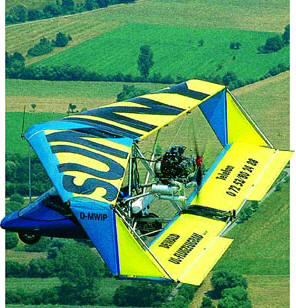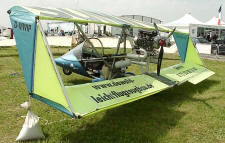|
The
result was that he bought not only a Sunny Side-by-Side and equipped it
with the 80hp four-stroke two-cylinder Verner engine, but also purchased
the rights to the crazy-looking design created by Dieter Schulz. Schulz
had produced the Sunny with the smaller Rotax 582 engines at his Tandem
Aircraft KG factory since 1989. In Dewald's new factory at
Sch?born-Mingolsheim, not far from
Speyer, both the tandem-seat (Sport) and side-by-side versions are now
produced. Both versions are equipped with the Verner engine and both
feature a number of small, but significant, design changes.
engine, but also purchased
the rights to the crazy-looking design created by Dieter Schulz. Schulz
had produced the Sunny with the smaller Rotax 582 engines at his Tandem
Aircraft KG factory since 1989. In Dewald's new factory at
Sch?born-Mingolsheim, not far from
Speyer, both the tandem-seat (Sport) and side-by-side versions are now
produced. Both versions are equipped with the Verner engine and both
feature a number of small, but significant, design changes.
The Verner is a small Czech aircraft engine with belt
reduction. It is conventional and old-fashioned, is not very light and
runs a bit rough, but it is reliable, cheap to buy and economic to run.
Equipped with this engine, the Sunny's empty weight rose to about 540lb,
leaving just 342lb for fuel and crew up to the maximum take-off weight of
882lb. When Dewald heard that a new and powerful lightweight Hirth engine
was being developed based on the well-known F-30 series, he immediately
ordered one for testing. The result was that he decided to certify and
offer this engine for the Sunny.
The F-30E is a one-litre four-cylinder two-stroke boxer
enginewith dual, electronic controlled ignition and electronic controlled
fuel management. It produces 83hp at 6,000 rpm and weighs only 93lb
(another new variant of this engine is the F-30ES, which produces 103hp at
6500 rpm, making it an attractive proposition for the builders of heavier
aircraft). Taking into account the reduction drive, cooling fans and
exhaust system, the final weight of the unit is 143lb. Equipped with this
engine, the empty weight of the Sunny went down again to 502lb, finally
making possible 'legal' dual flights with some fuel aboard.
At Speyer airfield, I had the chance to fly both the Verner-powered and
Hirth-engined 'Side by Side' versions. A cloth-covered aluminium alloy
tube, steel wire braced design, the 'tail-less arrow winged
tandem biplane' (or how would you call such a thing?) does not take up
much hangar space: Just 23ft x 11ft is enough. For those who have no
hangar, Dewald offers a suitable trailer, from which it only takes 20 to
30 minutes to rig or derig the aircraft .
Although the Sunny is a
microlight, Dewald uses only aviation aluminium alloy tubes, cut and
drilled by computer numeric controlled (CNC) machines, which makes
production easy and precise. The aircraft's weatherproof fabric covering
is manufactured in Switzerland. Preflighting the Sunny is simple:
everything is easy to see and easy to reach. It can carry ten gallons (an
option is 13) of 1:80 two-stroke mix in the two transparent tanks behind
the seats. You can see how much fuel remains can be seen from the seat in
a mirror at the strut. The strong main undercarriage, sprung by bungees,
also consists of aluminium alloy tubes.
| Manufacturer |
Dewald Light Aircraft |
| Seats |
2 |
| Power |
Hirth F30, Verner1400,
Rotax 912 |
| Cruising speed |
90 to 120 Km/h |
| Minimum speed |
55 Km/h |
| Climb rate |
800 to 1100 ft/min |
| Span |
7 meters |
| Length |
3.7 meters |
| Wing area |
17m? |
| Empty weight |
230 kg |
| Gross weight |
400 kg |
In this, the side-by-side version, the two comfortable seats are
positioned underneath the arrowed upper front wing. In the 'Sports'
version, the seats are in tandem. Either version provides plenty of space,
even for tall pilots. When entering the cockpit, the Sunny rocks forward
from her small tailwheel onto the rudder-pedal connected, steerable
nosewheel. One control stick is located in the centre between the seats,
equipped with a bicycle-type hydraulic wheel brake for the main
undercarriage wheels (the wheel brake can be locked for parking).
Backrests and pedals are not adjustable, so the more diminutive pilot will
need a cushion at his or her back. On the centre panel in front of the
stick are the main and ignition switches, starter button and the
altimeter. The engine instruments are in front of the altimeter some of
them are a little difficult to read as they are mounted at an angle where
their glass faces act as mirrors. The ASI, variometer and compass are
well-sited in the front instrument panel. The throttles are within
comfortable reach on the upper fuselage tubes, which form the right and
left cockpit wall: the handle to actuate the BRS aircraft rescue system
(mandatory for microlights in Germany) is in front of the left-hand one.
With the brake locked, and a bit of throttle set, I turned on the main
switch and the ignition, pressed the starter button, and the G?ler-Hirth
burst into life.
The prompt start, combined with reliable, smooth running with a low
vibration level, gives a much better impression than the older two-stroke
engines. On this Sunny, the engine turns a Helix three-bladed pusher
propeller. The noise level is low, but in the open cockpit you should
still wear a good headset. With its rudder-connected nosewheel, the Sunny
is easy to taxi and the wheel brakes are effective.
The engine warms up
quickly and reaches its operational temperature while still on the
taxiway. However, there is no risk of overheating even with a queue on the
runway as cooling is provided by two belt-driven fans in front of the
cylinder rows. With me in the seat and the fuel tanks full, the Sunny
weighs about 750lb, with the C of G in the rear range. Full throttle,
stick three-quarters back, and the Sunny is airborne after only a very
short ground run, climbing steeply with 43 knots indicated on the ASI. At
full throttle the engine is running at 5500 rpm, which is still below the
maximum allowed, so I can continue climbing at full throttle and reach
3,000ft above the airfield after barely three minutes. front of the
cylinder rows. With me in the seat and the fuel tanks full, the Sunny
weighs about 750lb, with the C of G in the rear range. Full throttle,
stick three-quarters back, and the Sunny is airborne after only a very
short ground run, climbing steeply with 43 knots indicated on the ASI. At
full throttle the engine is running at 5500 rpm, which is still below the
maximum allowed, so I can continue climbing at full throttle and reach
3,000ft above the airfield after barely three minutes.
Although the
outside air temperature is hot, the temperature of the cylinder head and
exhaust remain comfortably in the green arc. The new F-30E makes an
excellent impression running smoothly and reliably in any throttle
position, it does not show the bad habits of the old carburettor-fitted
two stroke engines, such as coughing under partial power, stopping when
the power setting is changed rapidly from idle to full, or throwing up
starting problems. The Verner-powered Sunny, equipped with a Junkers
four-blade propeller, is 37lb heavier and it takes about 90 seconds longer
to climb to the same altitude.
The cruise performance of the G?ler-Hirth
also beats the Verner. While the Verner-powered Sunny barely makes 62
knots, the F-30E gets the Sunny up to the certified Vne of 75 knots! The
Hirth's economic cruise speed setting of 4,500 rpm produces 65 knots,
resulting in a fuel consumption of just over three gallons an hour For
such a powerful two-stroke engine this is quite impressive, and not much
more than an 80hp Rotax 912 would use. However, the Verner returns the
best fuel flow figures, consuming just over two gallons an hour in the
(slightly slower) cruise. Story and photo of the Sunny courtesy of
http://www.todayspilot.co.uk/flight_tests/may02/2p1.html
|